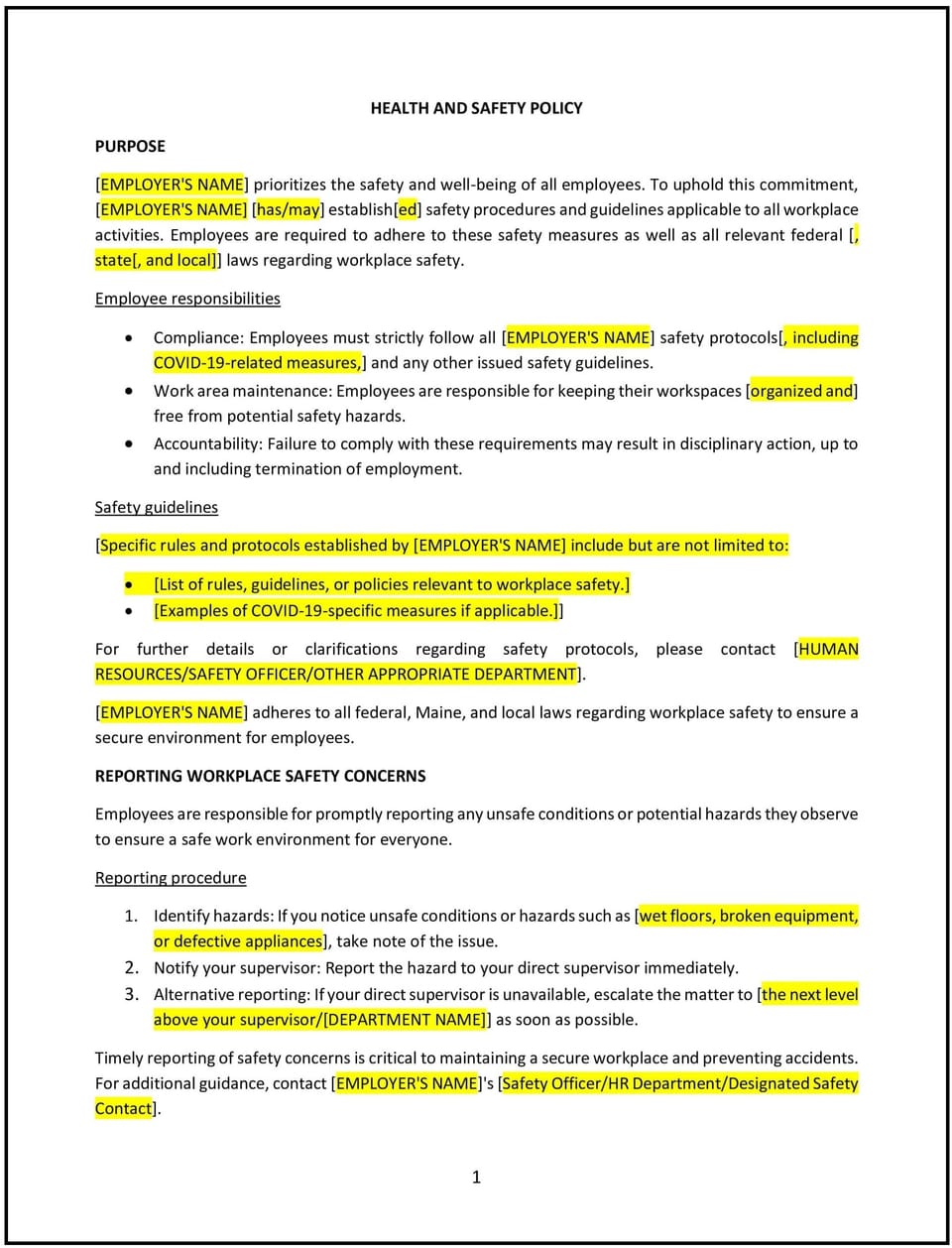Health and safety policy (Maine): Free template

Health and safety policy (Maine): Free template
This health and safety policy is designed to help Maine businesses maintain a safe and healthy work environment for employees, contractors, and visitors. It outlines responsibilities, safety procedures, and compliance measures to minimize risks and support adherence to Maine Occupational Safety and Health (OSHA) standards.
By implementing this policy, Maine businesses can reduce workplace incidents, improve employee well-being, and maintain compliance with state and federal safety regulations.
How to use this health and safety policy (Maine)
- Define scope and purpose: Specify that the policy applies to all employees, contractors, and visitors and outlines the business’s commitment to health and safety.
- Outline roles and responsibilities: Clearly assign safety-related duties to employees, supervisors, and management, ensuring accountability at all levels.
- Include safety procedures: Provide detailed guidelines for emergency response, equipment handling, hazard reporting, and workplace inspections.
- Address training requirements: Specify the frequency and type of safety training employees must complete, such as fire drills or equipment use.
- Detail reporting protocols: Include procedures for reporting workplace injuries, near misses, and unsafe conditions to ensure prompt corrective action.
- Establish compliance measures: Ensure adherence to Maine and federal OSHA standards, including regular audits and inspections.
- Review regularly: Update the policy to reflect changes in Maine regulations, workplace conditions, or industry practices.
Benefits of using this health and safety policy (Maine)
Implementing this policy provides several benefits for Maine businesses:
- Promotes employee well-being: Reduces risks and creates a safe working environment.
- Enhances compliance: Aligns with Maine and federal OSHA standards, minimizing legal and financial risks.
- Boosts productivity: Reduces disruptions caused by workplace accidents or unsafe conditions.
- Builds trust: Demonstrates the business’s commitment to employee health and safety.
- Encourages accountability: Clarifies responsibilities for maintaining a safe workplace.
Tips for using this health and safety policy (Maine)
- Train employees: Provide regular training on workplace safety protocols and emergency response procedures.
- Conduct regular inspections: Perform periodic workplace assessments to identify and address potential hazards.
- Foster open communication: Encourage employees to report safety concerns without fear of retaliation.
- Maintain records: Keep detailed documentation of training, inspections, incidents, and corrective actions.
- Use signage: Display clear safety instructions and hazard warnings in appropriate workplace areas.
- Stay compliant: Monitor updates to Maine OSHA regulations and adjust the policy as needed.
Q: What is the purpose of a health and safety policy?
A: The policy ensures a safe and healthy work environment by outlining procedures to minimize risks and support compliance with Maine OSHA standards.
Q: How can businesses promote workplace safety?
A: Businesses can conduct regular training, perform safety inspections, encourage hazard reporting, and maintain open communication about safety concerns.
Q: How often should businesses review their health and safety policy?
A: Businesses should review the policy annually or whenever there are changes to Maine OSHA regulations or workplace conditions.
Q: What responsibilities do employees have under this policy?
A: Employees are responsible for following safety procedures, reporting hazards, and using protective equipment as required.
Q: How should businesses handle workplace incidents?
A: Businesses should investigate incidents promptly, document findings, and implement corrective actions to prevent recurrence.
Q: What training should businesses provide under this policy?
A: Training should include emergency response, equipment handling, hazard identification, and any industry-specific safety requirements.
This article contains general legal information and does not contain legal advice. Cobrief is not a law firm or a substitute for an attorney or law firm. The law is complex and changes often. For legal advice, please ask a lawyer.


